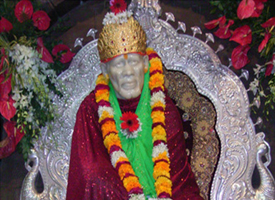Importance of Arti
Significance of Aarti
The devoted worship (Upasana) of the highest entity (Parameshwar), in its form with all its attributes is of great importance. For the ordinary man, the abstract idea, the formless concept of God, has always been incomprehensible. That is why worship (puja) performed with all its different accessories of the idol with flowers, garments and ornaments creates in the mind of the devotee a distinctive attachment for the Lord. Arati is a specially significant offering of worship. Because of the whole atmosphere created with the resounding music of auspicious musical instruments, Arati leads to the high concentration of the total congregation. The necessary atmosphere for utmost concentration is produced. That is why Arati, as an expression of devotion, has become respected by people and the devotees look upon it as a necessary contributive form of worship. Arati is an indigenous or Dravidian word and auspicious five lamps, incense, and lighted wicks are its different forms (for different timings of the day). In reality, Arati is not included in the sixteen forms of daily ritual worship. Similarly, Arati is not mentioned in the Five Upachars or Prakaar. It may be that Arati was introduced to Aryans after their contact with Dravidian culture and perhaps it became more popular in the Bhakti Tradition of worship or devotion to a personal God. This is gathered from available information. Even if the Arati is not included in the sixteen sub-rituals at the end of worship, there are various rites such as: 1. Holding the umbrella2. Waving silken flowing threads in front and at the sides.3. Song4. Music / Instruments5. Dance6. MovementsSince these later forms are included in Arati at the end of the formal Puja, Arati has become a form accepted by even the traditionalists and has increased in importance. In South India, Arati is an important ritual. And there, during the various Aratis offered, the waving of lamps, and ringing of sonorous bells, the blowing of the conch and playing of various instruments are continuous during the Arati. However, singing is absent. In Goa, there is a rich tradition of setting different Aratis to beautiful vocal music. Nevertheless, in large temples, at the time of Arati, the loud sounds of musical instruments is a noteworthy characteristic, but vocal singing is absent. The similar custom is prevalent to a certain extent in Maharashtra. In the Northern Provinces, this form of Arati is accepted but not as vigorously as it is in Maharashtra and in the South. Arati there is never set to Music.There are various ways to prepare for Arati. The commonest form is having a lamp with ghee and cotton wicks placed in a tray, lit and waved before the idol. Sometimes the lamps are of silver and even of gold. An offering of ghee is superior to an offering of oil, in the Niranjan. In some cases a bunch of cotton wicks fully moistened in oil is lit and waved in front of the idol. At the start of the Arati, the lamp with five wicks is used. In the South, beautifully shaped brass lamps are available in abundance. Some lamps are tall brass pillars, containing 108 lip-shaped wick-holders meant to be used for the Arati. To keep these spic and span and keep them provided with oil and wicks is the work designated to Devadasis. They receive an annual income for this duty from the temple. This practice is prevalent even in Goa, but not in folk-worship or Guru Sampradaya. Actually, Arati is a contribution of the people to the formal prescribed worship. By popular belief, a lamp is waved to ward off the evil eye and to keep away any evil or inauspicious effects. So at the time of weddings or the sacred thread ceremony, after smearing turmeric on the bride or the boy, they are protected from evil by the auspicious waving of the lamps. Similarly on Bhai-beej Day, Diwali, New Year, or when heroes return home, lamps are waved to keep them protected from the evil eye. It is also a belief that ghosts and evil spirits and animals are afraid of the brightness of fire.Light produced by fire is considered splendorous and this itself is a unique concept of all cultures and religions. Therefore, Arati has a special place in Bhakti worship. It is conjectured that Arati accompanied by song and music wards off evil influences obstructing the practice of Bhakti. One should note with significance that there is no singing in Sanskrit temples (traditional temples of gods and goddesses). It is distinctly present in Vithal Sampradaya in Maharashtra. It is also predominantly present in Guru Sampradaya, as it is in the temples of Datta Maharaj and Shri Sai Baba. According to the Guru tradition, the relationship between Guru and disciple and the bond between them and their merger is supposed to be the very heart of Bhakti, superior even to the worship of God. To the common man Vithal or Datta Guru or Sai Baba are closer than the remote, abstract concept of Sanskrit Iswara. That is probably the reason why people are drawn to the former. And this fact makes the basis of religion not just a creation through a miracle but a well-founded fountain of love through faith and experience. The potent expression of this prem is Arati. Taken from Worship of the Manifested Shri Sadguru Sainath by Zarine. (Meher-dhun Endowment)
We are presenting the Baba`s Aarti`s in five languages for the benefit of the devotees.
Quick Navigation
Subscribe to Sai News Letter


